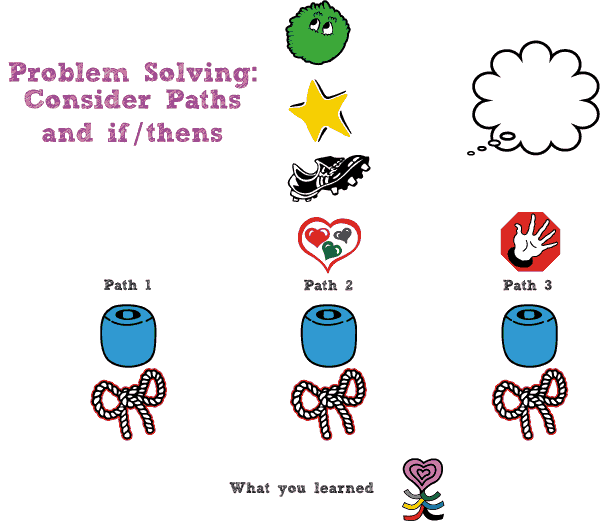Menu
-
- Home
-
About Us
-
The Approach
-
Linking Language & Literacy
-
MindWing Learning
-
Learning Resources
-
SHOP
-
Blog
-
- About MindWing
- Our People
- Contact Us
- Your Account
- Login
-
Spain (EUR €)

Tech Tuesday: Problem-Solving Approach Using Story Grammar Marker® Icons
May 29, 2018 3 min read
 Of late, I’ve unfortunately had a number of students who are needing to deal with getting teased or bullied. This is a tough area to intervene in because it is so sad and frustrating to see a young student being victimized, particularly when their social learning and communicative challenges likely are the reason why. It’s also difficult because we can’t really just provide one way to respond. “Ignore it,” being realistic, oftentimes does not work.
Of late, I’ve unfortunately had a number of students who are needing to deal with getting teased or bullied. This is a tough area to intervene in because it is so sad and frustrating to see a young student being victimized, particularly when their social learning and communicative challenges likely are the reason why. It’s also difficult because we can’t really just provide one way to respond. “Ignore it,” being realistic, oftentimes does not work.
Over the past few years, I have worked in these situations around problem-solving approaches, Story Grammar Marker® providing a great tool in the process. Problem-solving can be considered to be a forked format, with SGM®’s icons providing a guide to consider the who, where and when the problem involves, the nature of the problem itself, feelings and internal states/thoughts resulting, and the plan (in the case of teasing, to end it).
Students need to consider an if/then pathway and may have to try different actions to solve the problem! It would look like this:

— DOWNLOAD PROBLEM-SOLVING MAP —
I hope this file (download) might be of use to you in sketching out paths with students. Note that this problem-solving format is based on a few works: Westby and Noel’s BEST PLANS methodology and Social Thinking®’s Problem-Solving resources.
 A book which has been helpful to me in working through some potential actions with students, and which contains material that would align with both the use of the SGM® and Social Thinking®’s approach, is Speak Up and Get Along!: Learn the Mighty Might, Thought Chop, and More Tools to Make Friends, Stop Teasing, and Feel Good About Yourself. My tech tip is that I recommend the Kindle version.
A book which has been helpful to me in working through some potential actions with students, and which contains material that would align with both the use of the SGM® and Social Thinking®’s approach, is Speak Up and Get Along!: Learn the Mighty Might, Thought Chop, and More Tools to Make Friends, Stop Teasing, and Feel Good About Yourself. My tech tip is that I recommend the Kindle version.
A lot of my upper elementary and middle school students are less than enthralled if I attempt to read to them from a chapter book of this type. The Kindle edition (view within your iPad’s Kindle app, which you can also obtain for Mac and other devices). I use mirroring to an Apple TV if using the book with a group. Kindle allows you to bookmark key sections that you want to review with students, streamlining the material. The key idea in the book is that there are different actions or “Tools” that can be tried to respond to problem situations, and the book has a focus on dealing with bullying and teasing.
The book is themed around different birds and their tools, an animal connection that adds a nice removal from the problems your students might be facing. For example, the Tools of the Blue Jay exemplify the bird’s assertiveness and frequent “verbalizations,” while the Tools of the Hummingbird show bravery, such as the Hummingbird’s tendency to protect itself. In each chapter, multiple narratives are presented that could be mapped with SGM® and the above visual. Tools—essentially scripts—are described with many examples and even suggested practice activities.
A good example is within a section on the use of comebacks: “The Comeback Kid” is a Tool of the Hummingbird to attempt to show bravery and unflappability. “Complete Denial” is disagreeing with every single thing teasers say. For example, if somebody says you have freckles, you say, “No I don’t” (even if you do have freckles). If a teaser says you have a funny-looking nose, you say, “No I don’t.” Even if a teaser says the sky is blue, you say, “No it’s not.” After a few Complete Denials, teasers will usually get tired of trying to make you upset, and they’ll stop. This response is something your students might not have thought of and is definitely worth a try. The book also focuses on how to say differing responses in terms of body language and nonverbals, which can be a skill you can rehearse in sessions with students.
As in life, not all Kick-Offs are problems, but sometimes are opportunities. Speak Up also includes suggestions for tools that can help students make friends. “The Sherlock Holmes” (ask questions to get to know someone) aligns with Social Thinking®’s vocabulary around the use of “Wondering Questions” to show interest.
This book would make a good summer read for considering sections that could be used for group, individual or classroom lessons. Don’t forget the Kindle part!
Cooper, S. (2005). Speak Up and Get Along!: Learn the Mighty Might, Thought Chop, and More Tools to Make Friends, Stop Teasing, and Feel Good About Yourself (pp. 66-67). Free Spirit Publishing. Kindle Edition.
Leave a comment.
Comments will be approved before showing up.
